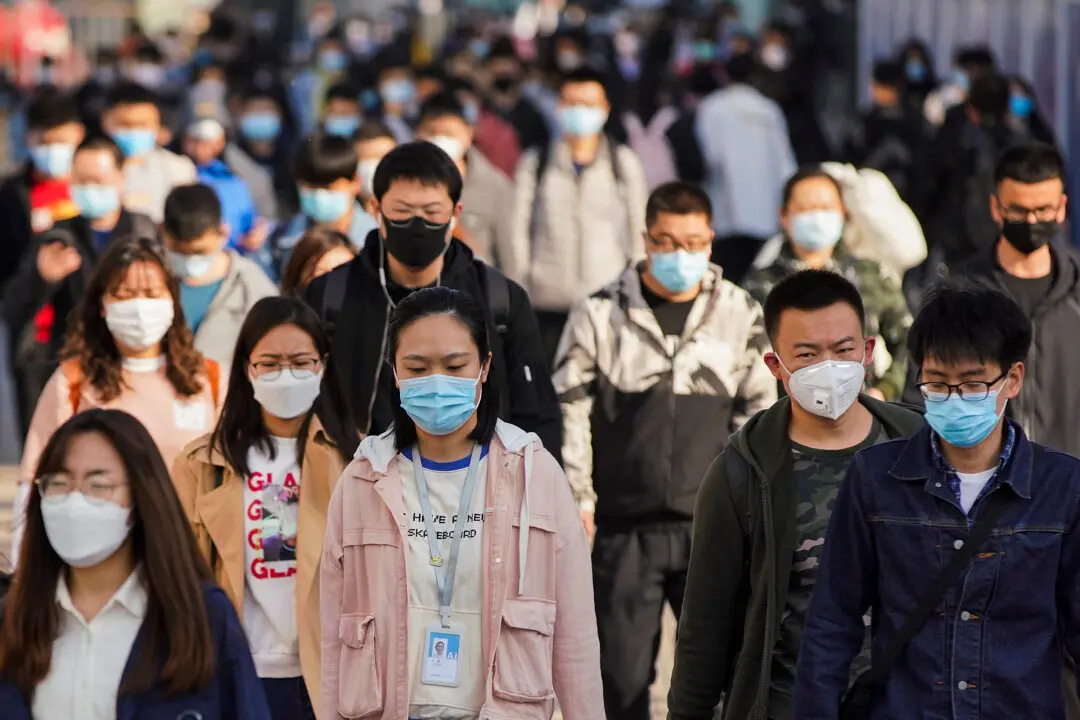COVID-19 infections have rebounded in China as a new immunity-evading variant spreads quickly, sparking concern among the populace because of the ruling communist party’s record of coverups and draconian lockdown restrictions.
The new strain, EG.5, has become the dominant COVID infection in many provinces in mainland China, China’s Center for Disease Control and Prevention (CDC) stated on the Chinese social media platform WeChat on Aug. 19.
“EG.5’s prevalence is mainly due to its enhanced ability to escape immunity, reducing the neutralizing ability of antibodies produced by previous infections,” the health agency said.
EG.5, also known as Eris, is a subvariant of the Omicron XBB.1.9.2. It has spread to at least 52 countries since it was first detected in Indonesia in February.
The variant is causing COVID-19 infections to surge around the world, with the United Nations’ World Health Organization (WHO) classifying it last week as a “variant of interest.”
“The proportion of the EG.5 variant among circulating strains of the coronavirus grew from 0.6 percent in April to 71.6 per cent in August,“ China’s CDC said. ”It has become the dominant strain in most provinces in China and is likely to continue this trend.”
The Guangdong Foshan Center for Disease Control and Prevention stated on Aug. 17 that the EG.5 mutant strain has become the dominant strain in Foshan City and is spreading.
Beijing’s Municipal Health Commission said in a weekly epidemic report on Aug. 15 that reported cases of infectious diseases rose from the previous week, with COVID-19 infections making up the most cases.
The prevalence of EG.5 in China from July 17 to July 23 rose to 45 percent from 24.7 percent, according to data previously released by the WHO.

Reinfections Reported
The mainland Chinese media outlet Shangguan News reported on Aug. 16 that several medical institutions in Shanghai noted that the number of COVID-19 outpatients has increased by 10 to 15 percent in recent days.Statistics from China’s CDC show that since the end of July, the national COVID-19 positive rate has risen by 13.4 percent.
In recent days, many people from across China have been posting on social media about a resurgence in COVID-19 infections.
“On the high-speed train G1189 bound for Shenzhen, the first half of the carriage is full of babies crying, and the second half of the carriage is occupied by a Hong Kong study tour group that has dozens of people who are all having a fever and walking around,” a mainland Chinese, whose social account name is “Lin Buli,” posted on Aug. 18. “They were also touching each other’s forehead to see who has the worst fever. I was desperate to find a mask.”
A Beijing resident posted, “By the end of July, there were more than 20 COVID-19 positive cases a day in Beijing’s fever clinics, and it reached 120 positive cases a day in mid-August.”
A Shanghai resident posted, “The number of people coughing in the company has increased significantly, and several people started wearing masks overnight.”

Professor Lu Hongzhou, president of the Shenzhen Third People’s Hospital, told China Business News on Aug. 17 that COVID-19 is still very contagious, and that infections are relatively invisible. Most people will get infected with COVID-19 one to three times a year, he said.
The Chinese health agency, meanwhile, is denying that the country is experiencing another wave of outbreak.
“The overall COVID-19 situation in China has remained at a low level, with a wavelike pattern. Little pressure has been posed to the health system across the country, and there is no indication of a large-scale outbreak in the short term,” the agency said.
Jin Dongyan, a professor at the University of Hong Kong and a virology expert, told Chinese media outlet China News on Aug. 17 that the COVID-19 virus has always been quite contagious. The virus is always mutating, and sometimes, it’s more contagious or pathogenic.

Meanwhile, the Chinese regime’s official media “Beijing Daily” reported on Aug. 21 that the municipal Center for Disease Control and Prevention has established the Beijing Major Respiratory Tract Infectious Disease Research Center.
Influenza viruses and coronaviruses are research priorities at the new center, due to the need to better prevent new regional epidemics of infectious respiratory diseases, according to Wang Quanyi, deputy director of the Beijing Center for Disease Control and Prevention. However, the authorities have avoided any mention of COVID-19 or the SARS viruses.
Some Chinese have posted messages on social media questioning the new research center.
“What kind of signal does this send?”






